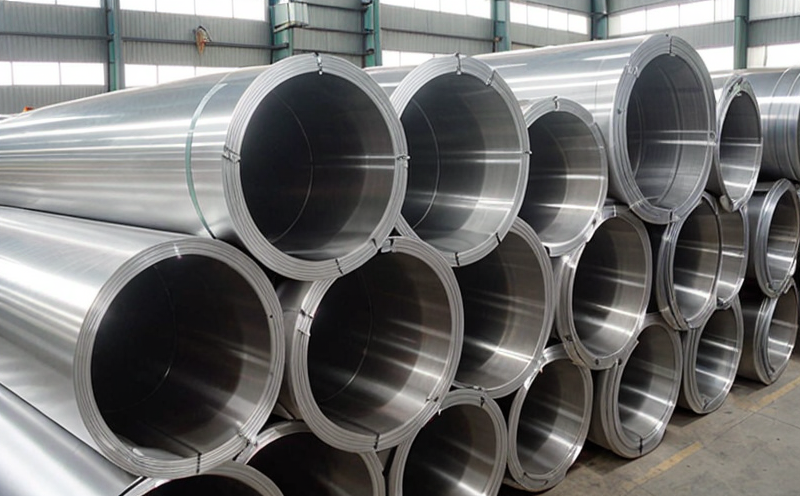IEC 60068-2-60 Flowing Mixed Gas Corrosion Testing
The IEC 60068-2-60 standard specifies the conditions and methods for testing materials, products, or components exposed to flowing mixed gas environments. This test is essential in assessing the corrosion resistance of materials used in marine applications where exposure to a mixture of gases—such as oxygen, carbon dioxide, and water vapor—can significantly impact their performance.
Aluminium materials are particularly susceptible to flowing mixed gas corrosion due to their high reactivity with various gases present in such environments. This test ensures that the aluminium components used in marine and ship equipment meet stringent quality standards by simulating real-world conditions they may encounter during operation.
The testing process involves exposing the specimen to a controlled mixture of gases at specific temperatures, pressures, and flow rates. The exposure duration is typically determined based on the expected service life of the component or material. After the test period, any changes in physical properties (such as weight loss) or surface alterations are measured to assess corrosion resistance.
For aluminium materials specifically, this test highlights potential issues with galvanic corrosion and pitting, which can be exacerbated by exposure to seawater and other corrosive environments in marine settings. The results of the IEC 60068-2-60 test are critical for ensuring that the components used in ship equipment withstand harsh marine conditions without compromising safety or functionality.
Understanding the unique properties of aluminium under flowing mixed gas conditions is crucial for designing robust and durable marine equipment. By adhering to this standard, manufacturers can ensure their products meet international quality benchmarks, thereby enhancing customer satisfaction and trust.
- Customer Impact: Reduced maintenance costs due to longer-lasting components; improved safety through more reliable materials; increased product longevity in harsh environments.
The IEC 60068-2-60 test provides a comprehensive evaluation of the performance and durability of aluminium materials under specific environmental conditions. This ensures that manufacturers can confidently use these materials in marine equipment, knowing they have been rigorously tested to withstand challenging operating conditions.
Why Choose This Test
Selecting the IEC 60068-2-60 flowing mixed gas corrosion test for aluminium materials offers several advantages. Firstly, it ensures that products meet international standards and are suitable for marine environments where exposure to corrosive gases is common. Secondly, this testing method helps identify potential weaknesses in material design or manufacturing processes early in the product lifecycle, allowing for improvements before large-scale production.
Compliance with IEC 60068-2-60 also enhances brand reputation by demonstrating a commitment to quality and safety. This can be particularly beneficial when dealing with high-risk applications such as ship equipment, where failures could have severe consequences. Additionally, passing this test increases marketability, making products more appealing to customers who prioritize reliability and durability.
In terms of operational efficiency, choosing the IEC 60068-2-60 test streamlines product development by providing clear guidelines on acceptable levels of corrosion resistance. This allows manufacturers to focus their efforts on other aspects of design without worrying about basic material performance. Ultimately, this leads to faster time-to-market and lower development costs.
The reliability provided by passing this test also reduces the risk of unexpected failures in the field. This is especially important for critical marine equipment where downtime or failure could result in significant financial losses or safety risks. By investing in thorough testing upfront, manufacturers can save on potential repair costs and improve overall customer satisfaction.
Quality and Reliability Assurance
The IEC 60068-2-60 flowing mixed gas corrosion test plays a vital role in ensuring the quality and reliability of aluminium materials used in marine equipment. By subjecting these materials to controlled environments that mimic real-world conditions, manufacturers can identify any vulnerabilities or weaknesses before they become critical issues.
One key aspect of this testing is the ability to simulate the effects of prolonged exposure to corrosive gases like oxygen, carbon dioxide, and water vapor. This helps in understanding how different environmental factors contribute to the degradation of aluminium surfaces over time. Such insights are invaluable for optimizing material selection and design practices.
The test also evaluates the resistance of aluminium materials to galvanic corrosion, a common problem in marine applications where dissimilar metals come into contact with each other. Galvanic corrosion can lead to premature failure of components if not properly addressed. By incorporating this aspect into the testing regimen, manufacturers can ensure that their products remain stable and effective throughout their operational lifecycles.
Another important benefit is the ability to assess the adhesion properties of coatings or surface treatments applied to aluminium surfaces. These treatments are often used to enhance corrosion resistance but must adhere well to the base material for optimal performance. The IEC 60068-2-60 test provides a standardized method for evaluating these qualities, ensuring consistent and reliable results.
Through rigorous testing according to this standard, manufacturers can gain confidence in their products' ability to perform reliably under demanding marine conditions. This not only enhances customer trust but also supports broader industry goals around sustainability and environmental responsibility by promoting the use of durable materials that require minimal maintenance over extended periods.





